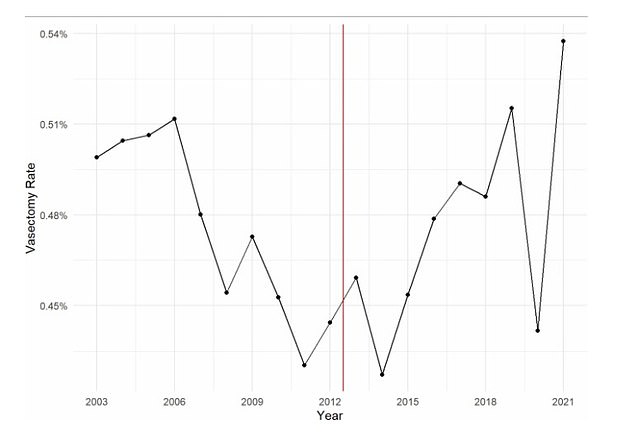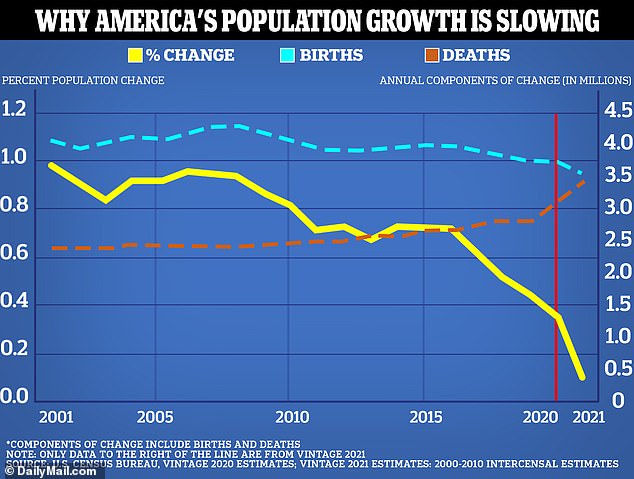Record number of American men are getting vasectomies as abortion access erodes
A record number of American men undergo vasectomy each year, a study suggests.
Researchers from the University of Chicago looked at annual insurance claims from 57 million people and found that the number of procedures performed annually between 2014 and 2021 increased by 26 percent.
A vasectomy is a surgical procedure to sterilize a man that involves cutting or closing the tubes that carry sperm from the testicles.
With access to abortion eroded since the overturn of Roe v. Wade, some doctors say vasectomies are probably even more popular now.
Planned Parenthood has started offering free vasectomies to young, uninsured men.
Erika Haas holds her friend Brad Bashor’s hand as Dr. Esgar Guarin performs a vasectomy on Mr. Bashor in his mobile vasectomy on Friday, November 4, 2022

The chart above shows how a record number of men are now going for a vasectomy
Scientists found that the proportion of men aged 18 to 64 who had a vasectomy rose to 0.54 percent by 2021, a new record.
This eclipses the previous record of 0.52 percent in 2018.
Men with two or more children or a woman over age 34 would be most likely to opt for the procedure, they said.
Geographically, those in the North Central area — including Iowa, the Dakotas and Missouri — were most likely to get the surgery.
Dr. Monica Dragoman, an obstetrician at New York’s Mount Sinai who was not involved in the study, told me UPI: ‘The reasons (for the upswing) are highly personal and multifactorial.
“But motivations can include worry about their partner and fear about having children they don’t want.”
Access to abortion could push rates further up since Roe v Wade, with 22 states now restricting the procedure and 15 having banned it completely.
For the study, researchers looked at vasectomies reported in the insurance claims database Merative MarketScan Commercial Databse — which covers up to 57 million Americans nationwide.
They only looked at men aged 18 to 64 who had the procedure between 2014 and 2021.
Men who were married to other men, whose marital status could not be determined or who had two or more spouses, were excluded.
An analysis was then performed to calculate a proportion based on the number of men in the database divided by the number who had a vasectomy, which the researchers said reflected the national proportion of men who had a vasectomy.
A total of 325,910 vasectomies were recorded during this seven-year period.
The share of vasectomies was 0.42 percent in 2014, the results showed, but by 2021 it had risen to 0.54 percent — a 26 percent increase and the highest share ever.
By age group, those in the 35 to 44 age range were also the most likely to have the surgery.
Doctors said this may be caused by men at this age feeling that they have already completed their family and do not want to have any more children.
The strongest increase was seen among men who had no children, with the proportion increasing by 61 percent during the study period.
It was followed by those who had a wife who was older than 34 (up 41 percent), were single (up 40 percent), and were between the ages of 18 and 24 (up 37 percent).
Doctors suggested that the rise may also be due to the procedure becoming more accessible.
It only takes about 10 minutes and can be performed under local anesthesia, they said, with minimal pain for the patients.
Doctors are also more likely to offer the procedure after the American Urological Association urged them in December 2012 to make it more accessible.

In the US, the number of births has decreased over time, while the number of deaths has increased, leading to a decrease in population

Fertility rates have fallen the most since 2005 in Utah, Arizona, Colorado, Nevada and California
Organizations like Planned Parenthood – which aims to stop unwanted pregnancies – also offer free vasectomies, which can drive up the numbers.
In October, the organization’s St. Louis and Southwestern Missouri chapter said it would perform 100 free vasectomies for uninsured and underinsured patients. It was the third year they offered the procedure.
The increase may also be driven by the perception that the procedure can be reversed.
Doctors say it’s possible, but the chances get smaller as a person leaves it after the procedure.
A vasectomy is a quick and normally painless procedure in which doctors block small tubes in the scrotum to prevent sperm from leaving a man’s body and causing pregnancy.
There is also another type of vasectomy in which a doctor numbs the scrotum before making two small cuts in the skin on each side of the scrotum to reach and then cut the tubes that carry the sperm out of the testicles.
A small piece is removed and both ends of the tubes are then closed, either by tying or by heat.
A man who has undergone a vasectomy can still ejaculate, but this ejaculate no longer contains sperm.
Nils Seubold underwent a vasectomy for The Nutcracker last year. He had considered the procedure for some time, but decided to take the plunge when Roe v Wade was overturned.
He said, “I’d definitely have to say it’s a really good choice for people who already have a decision about where they’re going in life… it’s definitely not as scary as you might think.”
After the US Supreme Court overturned federal abortion protections in June 2022 when it overturned Roe v Wade, demand for vasectomies, a male form of birth control, soared in the US.
In October 2022, clinics in parts of the country said they were seeing up to four times as many patients coming for surgery compared to before the June ruling.
Planned Parenthood said it saw a 53 percent increase nationwide in traffic to vasectomy information on its website following the Roe v Wade reversal.
Lawmakers responded to the growing demand. In 2024, a California law will go into effect to make vasectomies cheaper by allowing patients with private insurance to undergo the procedure at no cost, aside from monthly premiums.
Many men use the procedure to delay having children, and some try to reverse the procedure when they are ready to start a family.
Although the procedure can be reversed, experts consider it a permanent form of birth control.
